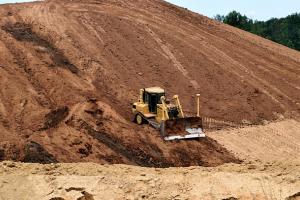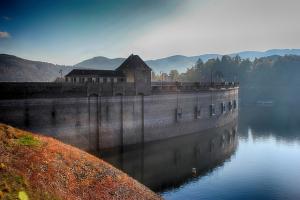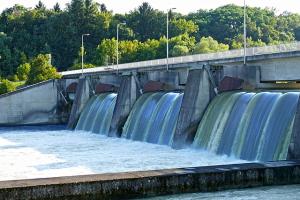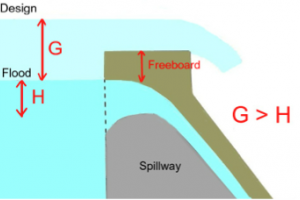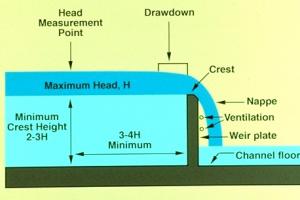Types And Location of Canal Headworks

Definition:
Any hydraulic structure which supplies water to the off taking canal. Diversion head-work provides an obstruction across a river, so that the water level is raised and water is diverted to the channel at required level. The increase water level helps the flow of water by gravity and results in increasing the commanded area and reducing the water fluctuations in the river.
Diversion head-work may serve as silt regulator into the channel. Due to the obstruction, the velocity of the river decreases and silt settles at the bed. Clear water with permissible percentage of silt is allowed to flow through the regulator into the channel.
Also See: Causes of Water Hammer
To prevent the direct transfer of flood water into the channel.
Functions of a Headwork
A headwork serves the following purposes
- A headwork raises the water level in the river
- It regulates the intake of water into the canal
- It also controls the entry of silt into the canal
- A head work can also store water for small periods of time.
- Reduces fluctuations in the level of supply in river
Types of Canal Headworks
- Storage headwork
- Diversion headwork
Storage Headworks
When dam is constructed across a river to form a storage reservoir, it is known as storage head work. It stores water during the period of excess supplies in the river and releases it when demand overtakes the available supplies.
Diversion Headworks
When a weir or barrage is constructed across a river to raise the water level and to divert the water to the canal, then it is known as diversion head work. The flow in the canal is controlled by canal head regulator.
Functions of Diversion Headworks
- It raises the water level in the river so that the command area can be increased.
- It regulates the intake of water into the canal.
- It controls the silt entry into the canal.
- It reduces fluctuations in the level of supply in the river.
- It stores water for tiding over small periods of short supplies.
A diversion headwork can further be sub-divided into two principal classes:
- Temporary spurs or bunds
- Permanent weirs and barrages
Temporary spurs or bunds
Temporary spurs or bunds are those which are temporary and are constructed every year after floods, however, for important works, weirs or barrages are constructed since they are of permanent nature if properly designed.
Weirs:
The weir is a solid obstruction put across the river to raise its water level and divert the water into the canal. If a weir also stores water for tiding over small periods of short supplies, it is called as ‘storage weir’. The main difference between the storage weir and dam is only in height and duration for which the supply is stored. A dam stores the supply for a comparatively longer duration.
Barrage:
The function of barrage is similar to that of weir; but the heading up of water is affected by the gates alone. No solid obstruction is put across the river. The crest level in the barrage is kept at a low level. During the floods, the gates are raised to clear off the high flood level, enabling the high flood to pass downstream to mix afflux. When the flood recedes, the gates are lowered and the flow is obstructed, thus raising the water level to upstream of the barrage. Due to this, there is less silting and better control over the levels. However, barrages are much more costly than weirs.
Component parts of Diversion Headwork
- Weir or Barrage
- Divide Wall
- Fish Ladder
- Approach Canal
- Silt prevention device
- Canal head regulator
- River training works
Location of Headworks
- Rocky Stage
- Sub mountainous or boulder stage: boulder or gravel
- Alluvial plan
Rocky stage:
River steep slope, high velocity
Advantages:
- Good foundation at shallow depth
- Comparatively silt free water for turbines
- High head for hydro-electric work
Disadvantages:
- Long ---- length of canal. In reach soil is good for agriculture.
- More cross damage works
- More falls (ground steep gradient - lined to permit high velocity)
- Costly head regulator excluding shingle
- Frequent repairs of the weirs.
Sub mountainous or boulder stage: boulder or gravel
Advantages:
- Less training works
- Suitable soil for irrigation available
- Availability of construction material locally.
- Falls can be utilized for power generation
Disadvantages:
- It has a strong sub-soil flow as a result
- Reduce in storage and damage floor downstream
- More percolation loss from canal
- More x-drainage works
- Less demand of water at head reaches (more idle length of canal)
Alluvial plan:
- x- section of river alluvial sand silt
- Bed slope small, velocity gentle
- No idle length of canal
- less x- drainage works
- Comparatively less sub soil flow
Disadvantages:
- Cost of head-work is more due to poor foundation
- More river training works
- Problem of silt in canal



